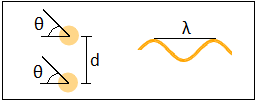2.6.5 X-ray diffraction
When a parallel beam of monochromatic radiation falls onto a crystal lattice (a regular periodic arrangement of atoms) diffracted beams can result only in definite directions. Diffraction can be interpreted as a reflection by the planes of the crystalline structure, when the lattice distance fulfils the conditions required for a coherent superposition of the reflected waves.

where:
λ is the wavelength of the incident x-rays beam.
d is the distance between atomic layers in a crystal or periodic layered structure.
θ is the angle of incidence.
If n is equal to any integer value, the reflected waves will be in phase and constructive interference will occur.
The effect of x-ray diffraction is used in the wave-length dispersive x-ray spectrometers to separate the radiation reaching the detector by wavelengths using single crystals with outstanding wavelength resolution, and in x-ray diffraction spectrometry to obtain spectra providing information on the lattice stricture d of the investigated crystalline structures.
X-ray diffraction at multi-layered structures allows modifying the excitation spectrum from x-rays tubes or from synchrotron radiation and obtaining intense quasi-monochromatic beams, a useful feature for selective x-ray excitation and easing quantification procedures.
